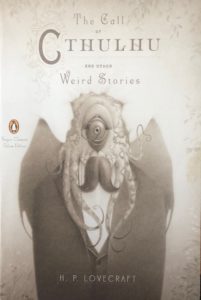
A fan of horror and science fiction from way back, I’ve come across countless references to H. P. Lovecraft, the early 20th-century New England horror story writer who influenced many of the great writers, filmmakers and artists in both genres. Prior to devouring this collection of his short stories, I had only read a smattering of Lovecraft’s fiction.
He certainly makes an impression, in spite of himself in many respects.
Lovecraft, you see, violates several “rules” of writing. He piles on adjectives. He frequently describes phenomena as being indescribable. His tortured sentence structure, further complicated by all those adjectives, continually interferes with the flow of his narrative. His protagonists are basically the same character, reminding me of Agent Scully of The X-Files. Like her, all of Lovecraft’s protagonists are rational people of a scientific bent exposed to ghastly, otherworldly phenomena, and who despite the obvious pileup of evidence to the contrary, stubbornly attribute these phenomena to natural causes. But unlike Dana Scully, Lovecraft’s protagonists lack depth and breadth of character. The author’s antagonists are as similar as his hero-victims — Humanoid, but with frog heads or fish heads or squid heads or something on that order. Always utterly alien, they are malevolent for reasons unknown and unknowable, and are impervious to human resistance. To round out the list of Lovecraft’s literary shortcomings, he commits two of the cardinal sins of today’s popular culture: He dislikes sex and exhibits many racial biases.

Nevertheless, Lovecraft’s stories are hard to put down. The atmosphere he creates is so utterly creepy — so dark, so alien, so dripping with danger and foreboding — that before long the reader finds himself immersed in the story, simultaneously dazzled and distraught by the goings-on, the bit-by-bit expansion of an odd occurrence or two into a horror big enough to destroy the universe as we know it.
Part of what makes his atmospherics so appealingly horrifying is another literary shortcoming — he writes more like an essayist than a writer of fiction. Rarely if ever do you find an exchange of dialog; if characters speak at all, it is in full paragraphs that read like a complex discourse. It’s a bit odd, but the lack of dialog is more than made up for by the detailed descriptions of mysterious clues, weird happenings, strange behavior and unnatural surroundings. Like I said, it’s creepy.
(Begin spoiler alert.) My two favorite stories among many excellent ones in this collection are The Colour Out of Space and The Shadow Over Innsmouth. Both stories have a methodical noose-tightening structure typical of this collection, where gradually and inexorably characters are drawn into a desperate doom. But more so than many of the other selections, these two stories have in addition crisp, exciting pacing and plotting.
Speaking of Dana Scully, The Colour of Space, in which an alien spacecraft (or sumthin’) lands on a remote New England farm, sets up perfectly as an X-Files episode; I’m surprised the show’s producers haven’t adapted it yet. Trees start moving with no wind to move them. Flowers and grass take on strange hues. Crops stop growing. Amphibious footprints appear in the dirt. Things get weirder and weirder, worse and worse for the inhabitants until the big shoe finally drops.
Whereas in The Colour Out of Space the storyline takes conditions from bad to worse, The Shadow Over Innsmouth kicks off with things having pretty much bottomed out. The remote New England town, viewed with a jaundiced eye by every neighboring community, turns out to be the devil’s playground (so to speak), as a curious visitor soon comes to learn. (End spoiler alert.)
If you’d like to sample some Lovecraft, this volume is an excellent place to start. The introduction, by S.T. Joshi, presents a solid overview of Lovecraft’s life and career; and his many literary, biographical and historical footnotes are fascinating. The cover art, by Travis Louie, captures the Lovecraftian spirit perfectly.
(Image credit – Wikimedia Commons)
